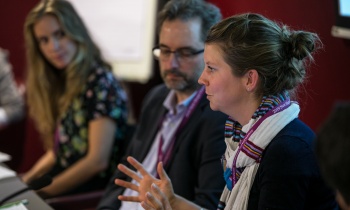How the Human Rights pillar is contributing to Arms Control

QUNO recently co-organized a discussion on “How the Human Rights pillar is contributing to Arms Control” as part of the New Shapes: Weapons Governance conference in October, in collaboration with the Women's League for Peace and Freedom (WILPF), Amnesty International, and the Permanent Mission of Peru to the United Nations. While the implementation of many arms control and disarmament frameworks, agreements and treaties is being undermined by politicization and commercial interests – UN human rights bodies are increasingly exploring their role in these spheres and reminding governments of their human rights obligations in relation to arms transfers. Indeed, action taken in recent years by UN human rights bodies continues to add an extra layer of accountability, complementing the Arms Trade Treaty (ATT) and reinforcing the notion that human rights must come ahead of profits from the arms trade.
The speakers explored how the Human Rights Council’s resolutions on the ‘Impact of arms transfers on human rights’ have evolved over the years, including by bringing a focus to the link between arms transfers and armed conflicts, to the gendered impacts of transfers, and to diversion, amongst other areas. Discussants also highlighted how human rights mechanisms such as the Universal Periodic Review (UPR) and the Committee on the Elimination of Discrimination against Women (CEDAW) or the Committee on Economic, Social and Cultural Rights (CESCR) are having real world impact to curb human rights violations from arms transfers. There was a particular interest in the State’s leverage to ensure companies meet standards set out in UN Guiding Principles on Business and Human Rights – with many suggesting that States should mandate human rights due diligence, making it an obligatory requirement in the overall licensing process.
For more please read our event report, available below.


